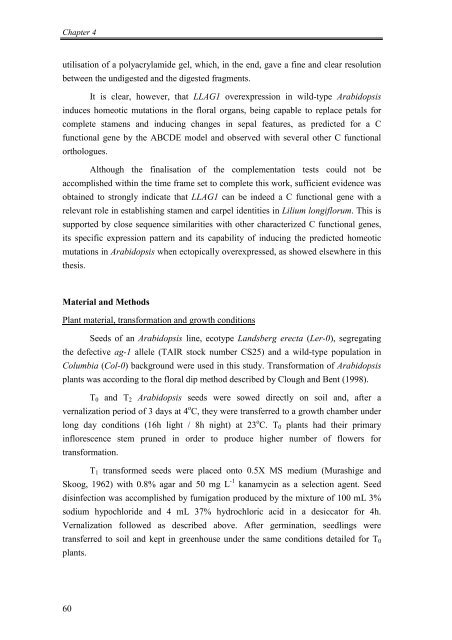Flower development of Lilium longiflorum - The Lilium information ...
Flower development of Lilium longiflorum - The Lilium information ...
Flower development of Lilium longiflorum - The Lilium information ...
You also want an ePaper? Increase the reach of your titles
YUMPU automatically turns print PDFs into web optimized ePapers that Google loves.
Chapter 4<br />
utilisation <strong>of</strong> a polyacrylamide gel, which, in the end, gave a fine and clear resolution<br />
between the undigested and the digested fragments.<br />
It is clear, however, that LLAG1 overexpression in wild-type Arabidopsis<br />
induces homeotic mutations in the floral organs, being capable to replace petals for<br />
complete stamens and inducing changes in sepal features, as predicted for a C<br />
functional gene by the ABCDE model and observed with several other C functional<br />
orthologues.<br />
Although the finalisation <strong>of</strong> the complementation tests could not be<br />
accomplished within the time frame set to complete this work, sufficient evidence was<br />
obtained to strongly indicate that LLAG1 can be indeed a C functional gene with a<br />
relevant role in establishing stamen and carpel identities in <strong>Lilium</strong> <strong>longiflorum</strong>. This is<br />
supported by close sequence similarities with other characterized C functional genes,<br />
its specific expression pattern and its capability <strong>of</strong> inducing the predicted homeotic<br />
mutations in Arabidopsis when ectopically overexpressed, as showed elsewhere in this<br />
thesis.<br />
Material and Methods<br />
Plant material, transformation and growth conditions<br />
Seeds <strong>of</strong> an Arabidopsis line, ecotype Landsberg erecta (Ler-0), segregating<br />
the defective ag-1 allele (TAIR stock number CS25) and a wild-type population in<br />
Columbia (Col-0) background were used in this study. Transformation <strong>of</strong> Arabidopsis<br />
plants was according to the floral dip method described by Clough and Bent (1998).<br />
T0 and T2 Arabidopsis seeds were sowed directly on soil and, after a<br />
vernalization period <strong>of</strong> 3 days at 4 o C, they were transferred to a growth chamber under<br />
long day conditions (16h light / 8h night) at 23 o C. T0 plants had their primary<br />
inflorescence stem pruned in order to produce higher number <strong>of</strong> flowers for<br />
transformation.<br />
T1 transformed seeds were placed onto 0.5X MS medium (Murashige and<br />
Skoog, 1962) with 0.8% agar and 50 mg L -1 kanamycin as a selection agent. Seed<br />
disinfection was accomplished by fumigation produced by the mixture <strong>of</strong> 100 mL 3%<br />
sodium hypochloride and 4 mL 37% hydrochloric acid in a desiccator for 4h.<br />
Vernalization followed as described above. After germination, seedlings were<br />
transferred to soil and kept in greenhouse under the same conditions detailed for T0<br />
plants.<br />
60














